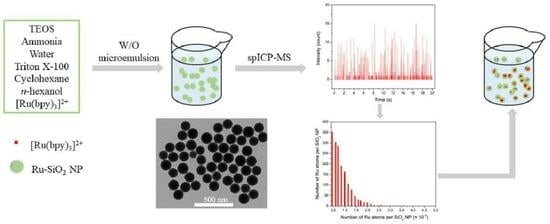An Unprecedented Metal Distribution in Silica Nanoparticles Determined by Single-Particle Inductively Coupled Plasma Mass Spectrometry
Abstract
:1. Introduction
2. Materials and Methods
2.1. Materials
2.2. Instruments
2.3. Synthesis of Metal-Doped SiO2 NPs
2.4. Characterization of MNP Shape and Size
2.5. Determinations of Metal Atoms per Particle
2.5.1. UV-Visible Absorbance Spectrophotometry
2.5.2. Conventional ICP-MS
2.5.3. Single-Particle ICP-MS
2.6. Histogram Distributions
3. Results
3.1. Synthesis and Characterization of Ru-SiO2 NPs
3.2. Average Metal Content of Ru-SiO2 NPs
3.3. Per-Particle Metal Content of Ru-SiO2 NPs
4. Discussion
5. Conclusions
Supplementary Materials
Author Contributions
Funding
Data Availability Statement
Acknowledgments
Conflicts of Interest
References
- Xie, W.; Shi, C.H.; Li, H.; Liu, L.; Zhao, Y.; Lin, C. Cu(II)-based metal–organic framework loaded with silver nanoparticles as a catalyst for the A3-coupling reaction. ACS Appl. Nano Mater. 2024, 7, 3210–3219. [Google Scholar] [CrossRef]
- Feng, Y.F.; Chen, X.D.; Wang, H.Z.; Li, X.L.; Huang, H.Z.; Liu, Y.; Li, H. Durable and high performing Ti supported Ni0.4Cu0.6Co2O4 nanoleaf-like array catalysts for hydrogen production. Renew. Energy 2021, 169, 660–669. [Google Scholar] [CrossRef]
- Eremina, O.E.; Yarenkov, N.R.; Bikbaeva, G.I.; Kapitanova, O.O.; Samodelova, M.V.; Shekhovtsova, T.N.; Kolesnikov, I.E.; Syuy, A.V.; Arsenin, A.V.; Volkov, V.S.; et al. Silver nanoparticle-based SERS sensors for sensitive detection of amyloid-β aggregates in biological fluids. Talanta 2024, 266, 124970. [Google Scholar] [CrossRef] [PubMed]
- Wu, J.Y.; Tou, F.Y.; Yang, Y.; Liu, C.; Hower, J.C.; Baalousha, M.; Wang, G.H.; Liu, M.; Hochella, M.F. Metal-containing nanoparticles in low-rank coal-derived fly ash from China: Characterization and implications toward human lung toxicity. Environ. Sci. Technol. 2021, 55, 6644–6654. [Google Scholar] [CrossRef] [PubMed]
- Tuli, H.S.; Joshi, R.; Kaur, G.; Garg, V.K.; Sak, K.; Varol, M.; Kaur, J.; Alharbi, S.A.; Alahmadi, T.A.; Aggarwal, D.; et al. Metal nanoparticles in cancer: From synthesis and metabolism to cellular interactions. J. Nanostruct. Chem. 2023, 13, 321–348. [Google Scholar] [CrossRef]
- Prasad, A.; Khatua, A.; Mohanta, Y.K.; Saravanan, M.; Meena, R.; Ghosh, I. Low-dose exposure to phytosynthesized gold nanoparticles combined with glutamine deprivation enhances cell death in the cancer cell line HeLa via oxidative stress-mediated mitochondrial dysfunction and G0/G1 cell cycle arrest. Nanoscale 2022, 14, 10399–10417. [Google Scholar] [CrossRef] [PubMed]
- Niska, K.; Zielinska, E.; Radomski, M.W.; Inkielewicz-Stepniak, I. Metal nanoparticles in dermatology and cosmetology: Interactions with human skin cells. Chem.-Biol. Interac. 2018, 295, 38–51. [Google Scholar] [CrossRef] [PubMed]
- Ivaneev, A.I.; Ermolin, M.S.; Fedotov, P.S. Separation, characterization, and analysis of environmental nano- and microparticles: State-of-the-art methods and approaches. J. Anal. Chem. 2021, 76, 413–429. [Google Scholar] [CrossRef]
- Jiang, C.; Liu, S.; Zhang, T.; Liu, Q.; Alvarez, P.J.J.; Chen, W. Current methods and prospects for analysis and characterization of nanomaterials in the environment. Environ. Sci. Technol. 2022, 56, 7426–7447. [Google Scholar] [CrossRef]
- Bolea, E.; Jimenez, M.S.; Perez-Arantegui, J.; Vidal, J.C.; Bakir, M.; Ben-Jeddou, K.; Gimenez-Ingalaturre, A.C.; Ojeda, D.; Trujillo, C.; Laborda, F. Analytical applications of single particle inductively coupled plasma mass spectrometry: A comprehensive and critical review. Anal. Methods 2021, 13, 2742–2795. [Google Scholar] [CrossRef]
- Laycock, A.; Clark, N.J.; Clough, R.; Smith, R.; Handy, R.D. Determination of metallic nanoparticles in biological samples by single particle ICP-MS: A systematic review from sample collection to analysis. Environ. Sci. Nano 2022, 9, 420–453. [Google Scholar] [CrossRef] [PubMed]
- Torregrosa, D.; Grindlay, G.; De La Guardia, M.; Gras, L.; Mora, J. Determination of metallic nanoparticles in air filters by means single particle inductively coupled plasma mass spectrometry. Talanta 2023, 252, 123818. [Google Scholar] [CrossRef] [PubMed]
- Bai, Q.S.; Li, Q.C.; Liu, J.F. Determination of the particle number concentration, size distribution, and species of dominant silver-containing nanoparticles in soils by single-particle ICP-MS. Environ. Sci. Technol. 2023, 57, 6425–6434. [Google Scholar] [CrossRef] [PubMed]
- Pusuwan, P.; Siripinyanond, A. Observing zinc oxide nanoparticles suspension stability in various media by using single particle inductively coupled plasma mass spectrometry (SP-ICP-MS). Microchem. J. 2024, 196, 109705. [Google Scholar] [CrossRef]
- Montoro Bustos, A.R.; Purushotham, K.P.; Possolo, A.; Farkas, N.; Vladár, A.E.; Murphy, K.E.; Winchester, M.R. Validation of single particle ICP-MS for routine measurements of nanoparticle size and number size distribution. Anal. Chem. 2018, 90, 14376–14386. [Google Scholar] [CrossRef] [PubMed]
- Gimenez-Ingalaturre, A.C.; Ben-Jeddou, K.; Perez-Arantegui, J.; Jimenez, M.S.; Bolea, E.; Laborda, F. How to trust size distributions obtained by single particle inductively coupled plasma mass spectrometry analysis. Anal. Bioanal. Chem. 2023, 415, 2101–2112. [Google Scholar] [CrossRef] [PubMed]
- Montoro Bustos, A.R.; Murphy, K.E.; Winchester, M.R. Evaluation of the potential of single particle ICP-MS for the accurate measurement of the number concentration of AuNPs of different sizes and coatings. Anal. Chem. 2022, 94, 3091–3102. [Google Scholar] [CrossRef] [PubMed]
- Minelli, C.; Bartczak, D.; Peters, R.; Rissler, J.; Undas, A.; Sikora, A.; Sjöström, E.; Goenaga-Infante, H.; Shard, A.G. Sticky measurement problem: Number concentration of agglomerated Nanoparticles. Langmuir 2019, 35, 4927–4935. [Google Scholar] [CrossRef]
- Xing, Y.; Han, J.; Wu, X.; Pierce, D.T.; Zhao, J.X. Graphene/gold nanoparticle composites for ultrasensitive and versatile biomarker assay using single-particle inductively-coupled plasma/mass spectrometry. Analyst 2020, 145, 7932–7940. [Google Scholar] [CrossRef]
- Xing, Y.; Han, J.; Wu, X.; Pierce, D.T.; Zhao, J.X. Aggregation-based determination of mercury(II) using DNA-modified single gold nanoparticle, T-Hg(II)-T interaction, and single-particle ICP-MS. Microchim. Acta 2019, 187, 56. [Google Scholar] [CrossRef]
- Merrifield, R.C.; Stephan, C.; Lead, J.R. Single-particle inductively coupled plasma mass spectroscopy analysis of size and number concentration in mixtures of monometallic and bimetallic (core-shell) nanoparticles. Talanta 2017, 162, 130–134. [Google Scholar] [CrossRef]
- Merrifield, R.C.; Stephan, C.; Lead, J. Determining the concentration dependent transformations of Ag nanoparticles in complex media using SP-ICP-MS and Au@Ag core-shell nanoparticles as tracers. Environ. Sci. Technol. 2017, 51, 3206–3213. [Google Scholar] [CrossRef]
- Hendriks, L.; Gundlach-Graham, A.; Gunther, D. Performance of sp-ICP-TOFMS with signal distributions fitted to a compound Poisson model. J. Anal. Atom. Spectrom. 2019, 34, 1900–1909. [Google Scholar] [CrossRef]
- Koolen, C.D.; Torrent, L.; Agarwal, A.; Meili-Borovinskaya, O.; Gasilova, N.; Li, M.; Luo, W.; Züttel, A. High-throughput sizing, counting, and elemental analysis of anisotropic multimetallic nanoparticles with single-particle inductively coupled plasma mass spectrometry. ACS Nano 2022, 16, 11968–11978. [Google Scholar] [CrossRef]
- Heetpat, N.; Sumranjit, J.; Siripinyanond, A. Use of single particle inductively coupled plasma mass spectrometry for understanding the formation of bimetallic nanoparticles. Talanta 2022, 236, 122871. [Google Scholar] [CrossRef]
- Martinez-Mora, O.; Tirez, K.; Beutels, F.; Brusten, W.; Leon-Fernandez, L.F.; Fransaer, J.; Dominguez-Benetton, X.; Velimirovic, M. Exploring Pt-Pd alloy nanoparticle cluster formation through conventional sizing techniques and single-particle inductively coupled plasma—Sector field mass spectrometry. Nanomaterials 2023, 13, 2610. [Google Scholar] [CrossRef] [PubMed]
- Smith, J.E.; Wang, L.; Tan, W.H. Bioconjugated silica-coated nanoparticles for bioseparation and bioanalysis. Trends Anal. Chem. 2006, 25, 848–855. [Google Scholar] [CrossRef]
- Ni, N.Y.; Su, Y.Q.; Wei, Y.C.; Ma, Y.L.; Zhao, L.Z.; Sun, X. Tuning nanosiliceous framework for enhanced cancer theranostic applications. Adv. Ther. 2021, 4, 2000218. [Google Scholar] [CrossRef]
- Jiang, Y.Y.; Pu, K.Y. Multimodal biophotonics of bemiconducting polymer nanoparticles. Acc. Chem. Res. 2018, 51, 1840–1849. [Google Scholar] [CrossRef]
- Gubala, V.; Giovannini, G.; Kunc, F.; Monopoli, M.P.; Moore, C.J. Dye-doped silica nanoparticles: Synthesis, surface chemistry and bioapplications. Cancer Nanotechnol. 2020, 11, 1. [Google Scholar] [CrossRef]
- Bagwe, R.P.; Yang, C.Y.; Hilliard, L.R.; Tan, W.H. Optimization of dye-doped silica nanoparticles prepared using a reverse microemulsion method. Langmuir 2004, 20, 8336–8342. [Google Scholar] [CrossRef] [PubMed]
- Yazdimamaghani, M.; Barber, Z.B.; Moghaddam, S.P.H.; Ghandehari, H. Influence of silica nanoparticle density and flow conditions on sedimentation, cell uptake, and cytotoxicity. Mol. Pharaceut. 2018, 15, 2372–2383. [Google Scholar]
- Boyd, R.D.; Cuenat, A.; Meli, F.; Klein, T.; Frase, C.G.; Gleber, G.; Krumrey, M.; Duta, A.; Duta, S.; Hogstrom, R.; et al. Good Practice Guide for the Determination of the Size and Size Distribution of Spherical Nanoparticle Samples; Good Practice Guide No. 119; National Physical Laboratory: Teddington, UK, 2011. [Google Scholar]
- Liang, S.; Shephard, K.; Pierce, D.T.; Zhao, J.X. Effects of a nanoscale silica matrix on the fluorescence quantum yield of encapsulated dye molecules. Nanoscale 2013, 5, 9365–9373. [Google Scholar] [CrossRef]
- Single Particle Calculation Tool, sp-ICPMS-Procedure (Version 2), RIKILT Wageningen UR as Part of Wageningen University and Research Centre, Copyright 2014. Available online: https://www.wur.nl/en/show/Single-Particle-Calculation-tool.htm (accessed on 7 June 2022).
- Pace, H.E.; Rogers, N.J.; Jarolimek, C.; Coleman, V.A.; Higgins, C.P.; Ranville, J.F. Determining transport efficiency for the purpose of counting and sizing nanoparticles via single particle inductively coupled plasma mass spectrometry. Anal. Chem. 2011, 83, 9361–9369. [Google Scholar] [CrossRef] [PubMed]
- Laborda, F.; Jimenez-Lamana, J.; Bolea, E.; Castillo, J.R. Selective identification, characterization and determination of dissolved silver(I) and silver nanoparticles based on single particle detection by inductively coupled plasma mass spectrometry. J. Anal. Atom. Spectrom. 2011, 26, 1362–1371. [Google Scholar] [CrossRef]
- Tuoriniemi, J.; Cornelis, G.; Hassellov, M. Size discrimination and detection capabilities of single-particle ICPMS for environmental analysis of silver particles. Anal. Chem. 2012, 84, 3965–3972. [Google Scholar] [CrossRef] [PubMed]
- Laborda, F.; Jimenez-Lamana, J.; Bolea, E.; Castillo, J.R. Single particle inductively coupled plasma mass spectrometry as screeing for detecton of partices. Spectrochim. Acta Part B 2019, 159, 105654. [Google Scholar] [CrossRef]
- Zhao, X.; Tapec-Dytioco, R.; Tan, W. Ultrasensitive DNA detection using highly fluorescent bioconjugated nanoparticles. J. Am. Chem. Soc. 2003, 125, 11474–11475. [Google Scholar] [CrossRef]
- Bagwe, R.P.; Hilliard, L.R.; Tan, W. Surface modification of silica nanoparticles to reduce aggregation and nonspecific binding. Langmuir 2006, 22, 4357–4362. [Google Scholar] [CrossRef]
- Jin, Y.H.; Lohstreter, S.; Pierce, D.T.; Parisien, J.; Wu, M.; Hall, C.; Zhao, J.X. Silica nanoparticles with continuously tunable sizes: Synthesis and size effects on cellular contrast imaging. Chem. Mater. 2008, 20, 4411–4419. [Google Scholar] [CrossRef]
- Liu, J.Y.; Murphy, K.E.; MacCuspie, R.I.; Winchester, M.R. Capabilities of single particle inductively coupled plasma mass spectrometry for size measurement of nanoparticles: A case study on gold nanoparticles. Anal. Chem. 2014, 86, 3405–3414. [Google Scholar] [CrossRef] [PubMed]
- Liu, J.Y.; Wei, X.; Wu, C.X.; Zheng, L.N.; Wang, M.; Chen, M.L.; Wang, J.H. Data analysis for the characterization of nanoparticles with single particle inductively coupled plasma mass spectrometry: From microsecond to millisecond dwell times. Anal. Chim. Acta 2023, 1254, 341114. [Google Scholar] [CrossRef]
- Han, J. Chapter II Optimization of Single-Particle ICP-MS and the Influence of Particle Size. Ph.D. Dissertation, University of North Dakota, Grand Forks, ND, USA, 2021. [Google Scholar]
- Degueldre, C.; Favarger, P.-Y.; Wold, S. Gold colloid analysis by inductively coupled plasma-mass spectrometry in a single particle mode. Anal. Chim. Acta 2006, 555, 263–268. [Google Scholar] [CrossRef]
- Laborda, F.; Bolea, E.; Jimenez, M.S. Single particle inductively coupled plasma mass spectrometry. Anal. Chem. 2013, 86, 2270–2278. [Google Scholar] [CrossRef] [PubMed]
- Laborda, F.; Abad-Alvaro, I.; Jimenez, M.S.; Bolea, E. Catching particles by atomic spectrometry: Benefots and limitations of single particle–indictively coupled plasma spectrometry. Spectrochim. Acta Part B 2023, 199, 106570. [Google Scholar] [CrossRef]
- Hunter, T.F. The distribution of solubilisate molecules in micellar assemblies. Chem. Phys. Lett. 1980, 75, 152–155. [Google Scholar] [CrossRef]
- Jain, R.; Mehra, A. Monte Carlo models for nanoparticle formation in two microemulsion systems. Langmuir 2004, 20, 6507–6513. [Google Scholar] [CrossRef] [PubMed]
- Leen, C.J.; Thomassen, L.C.J.; Aerts, A.; Rabolli, V.; Lison, D.; Gonzalez, L.; Kirsch-Volders, M.; Napierska, D.; Hoet, P.H.; Kirschhock, C.E.A.; et al. Synthesis and characterization of stable monodisperse silica nanoparticle sols for in vitro cytotoxicity testing. Langmuir 2010, 26, 328–335. [Google Scholar]
- Liu, Y.; Pan, W.; Wang, M.; Zhang, K.; Zhang, H.; Huang, B.; Zhang, W.; Tan, Q.; Miao, A. Silica nanoparticle size determines the mechanisms underlying the inhibition of iron oxide nanoparticle uptake by Daphnia magna. Environ. Sci. Technol. 2024, 58, 751–759. [Google Scholar] [CrossRef]
- Geiss, O.; Bianchi, I.; Bucher, G.; Verleysen, E.; Brassinne, F.; Mast, J.; Loeschner, K.; Givelet, L.; Cubadda, F.; Ferraris, F.; et al. Determination of the Transport Efficiency in spICP-MS Analysis Using Conventional Sample Introduction Systems: An Interlaboratory Comparison Study. Nanomaterials 2022, 12, 725. [Google Scholar] [CrossRef]
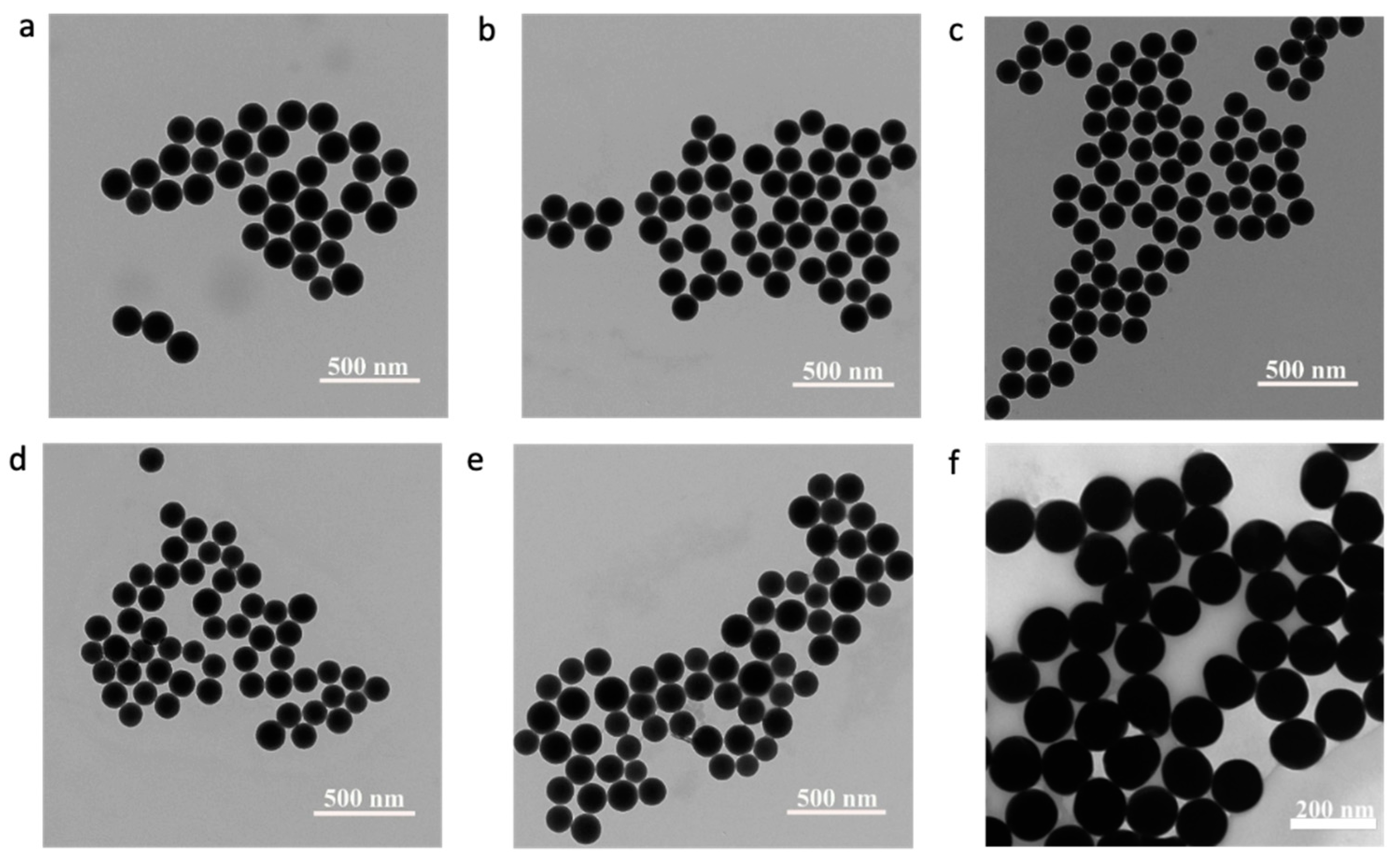
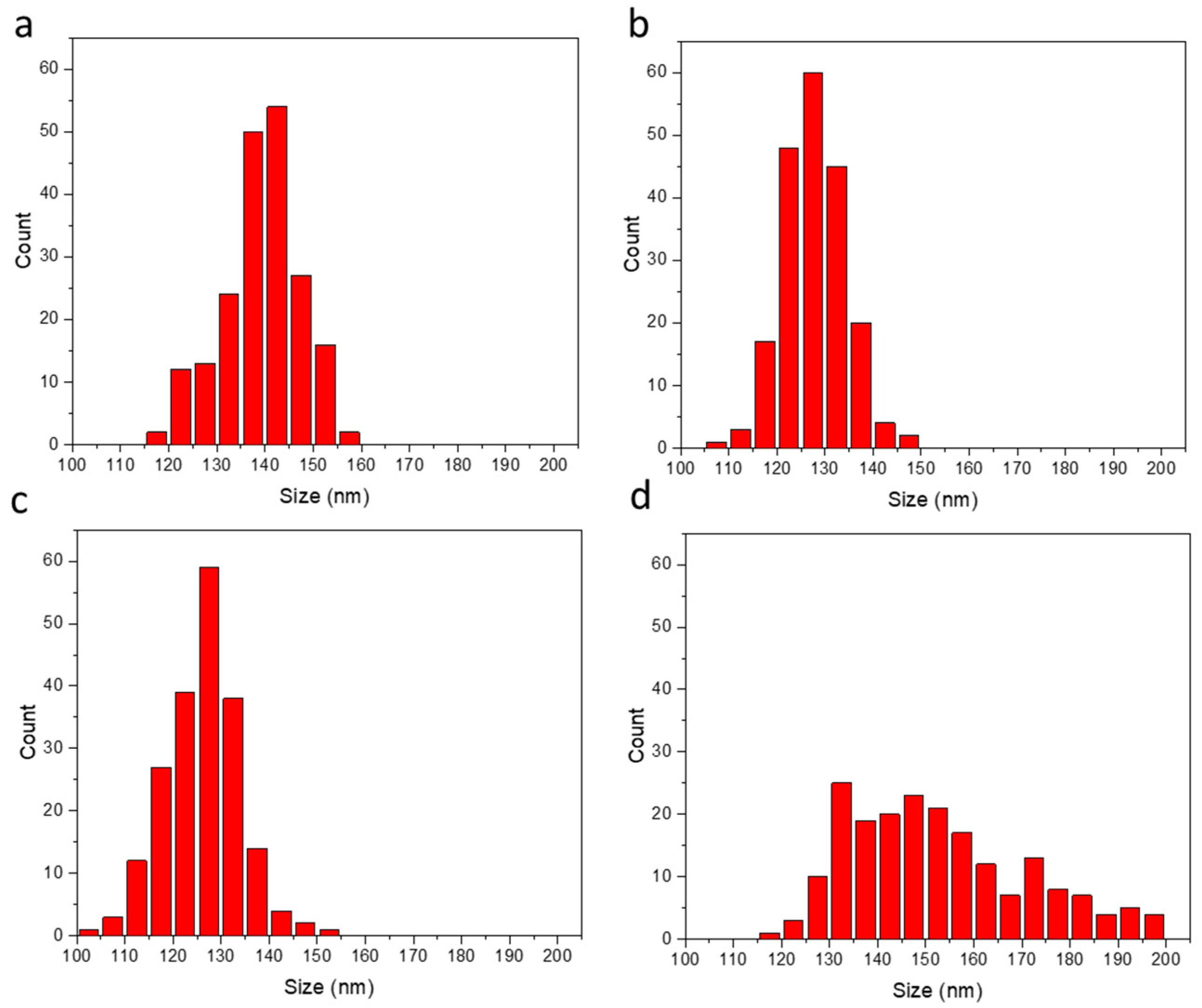

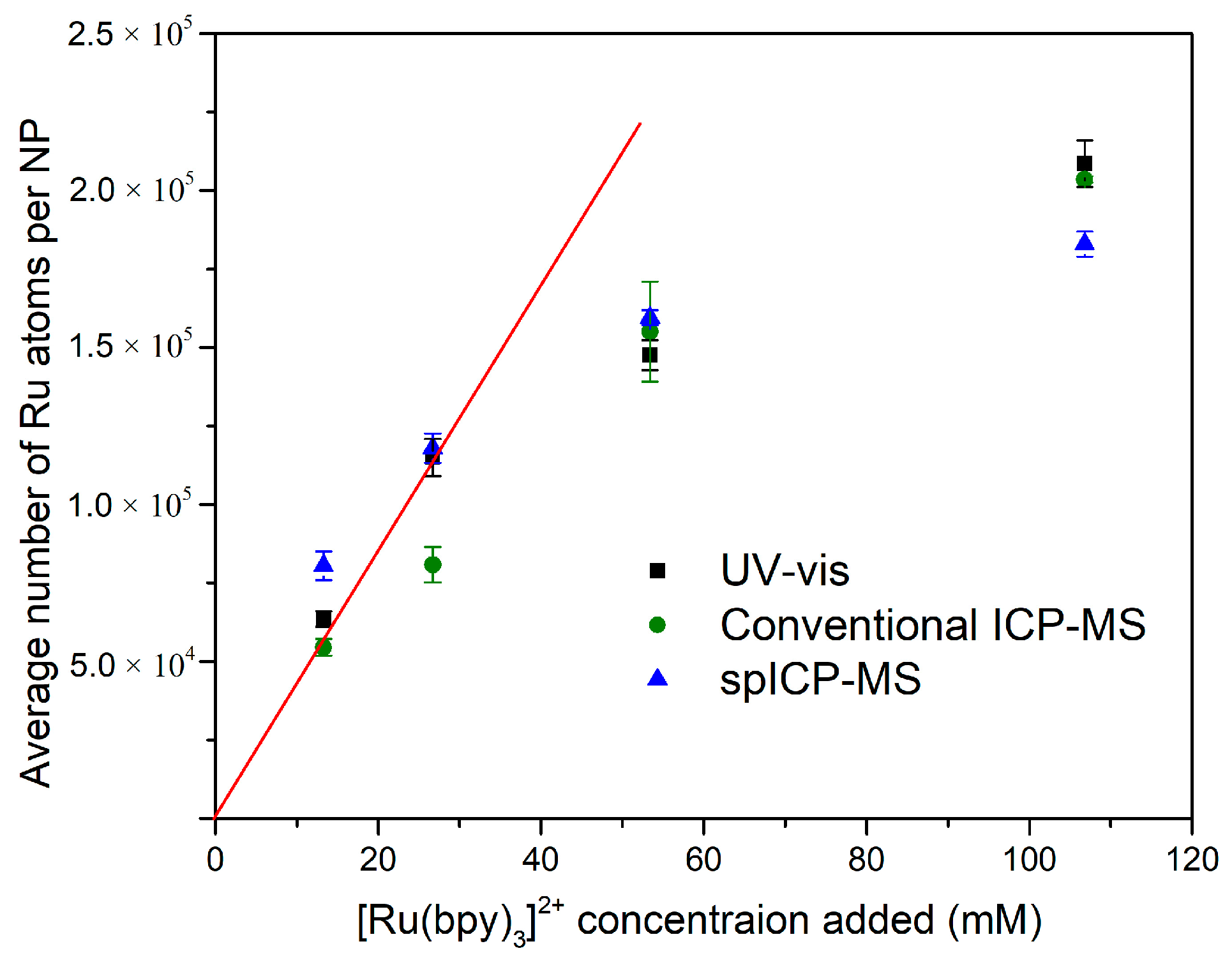
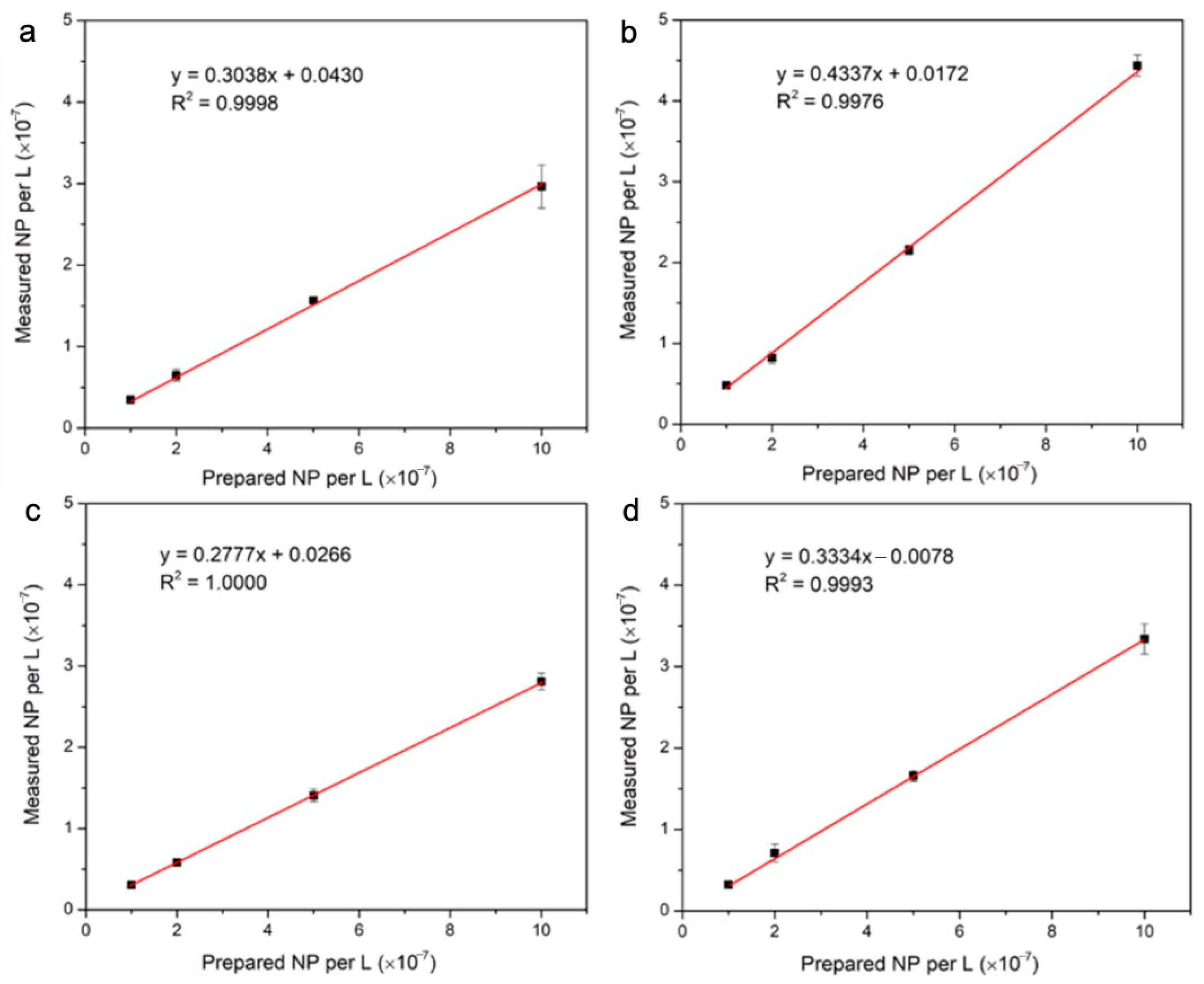
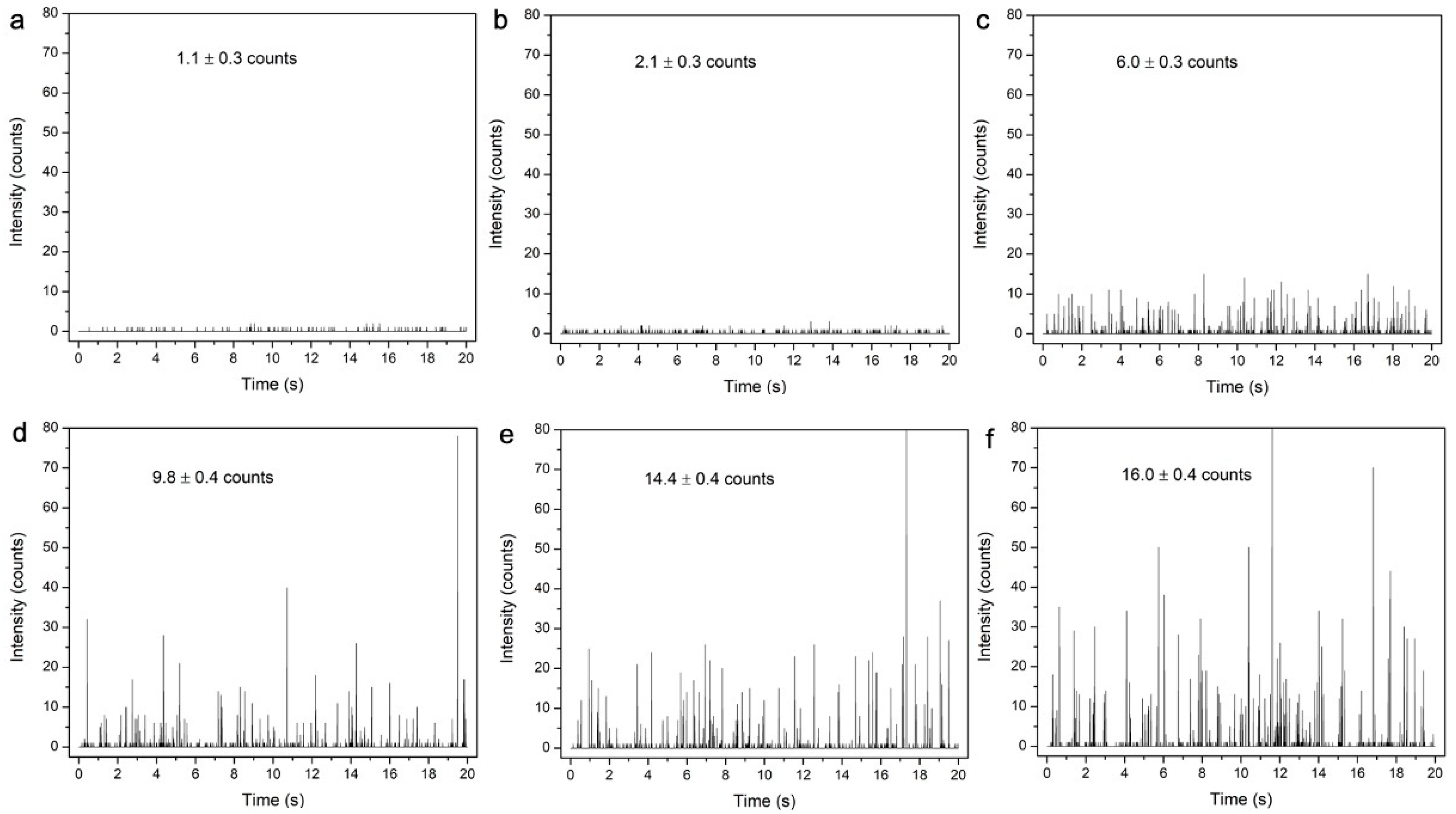
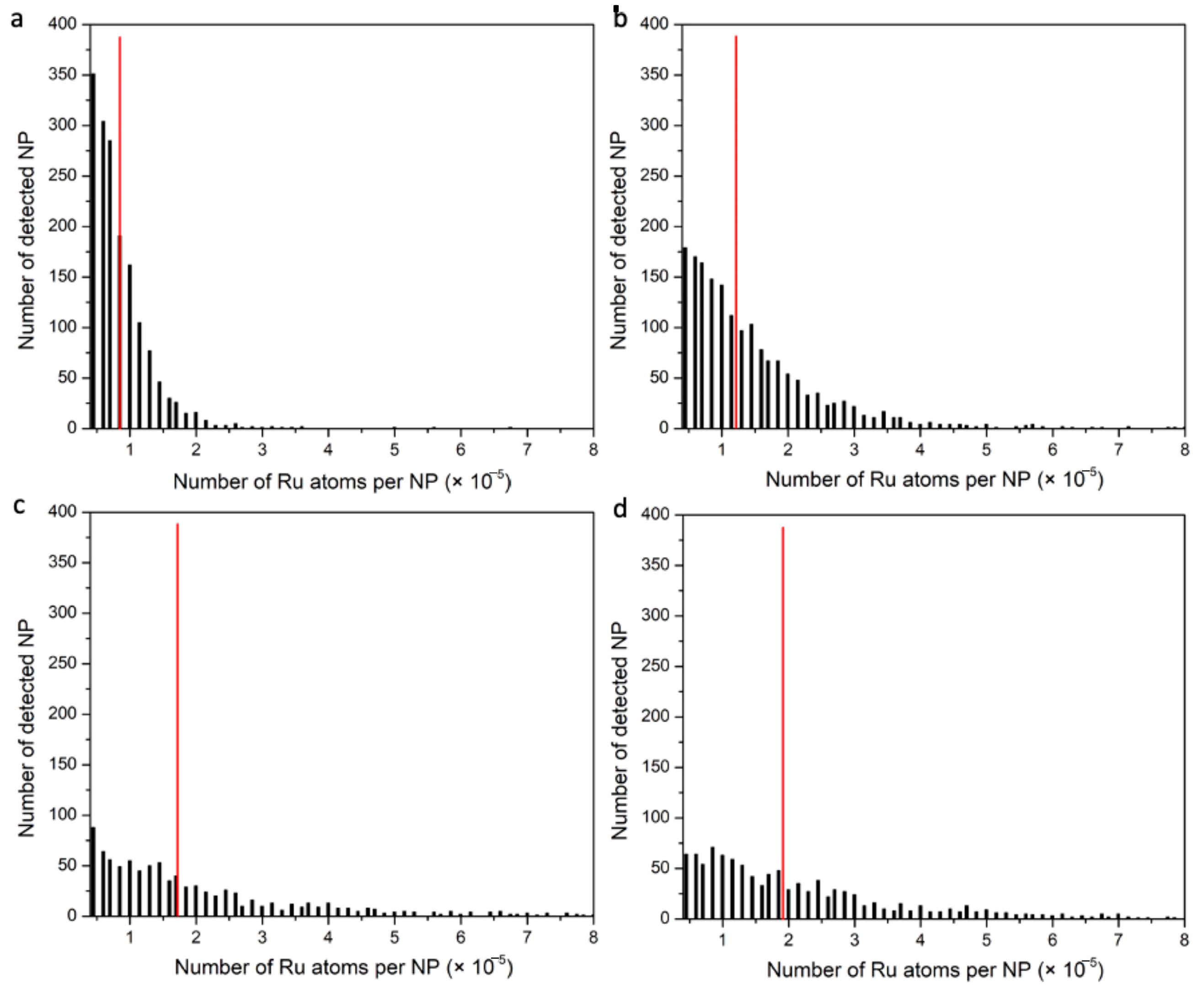


| Parameter | Conventional | Single-Particle |
|---|---|---|
| Sample introduction | ||
| peristaltic pump | 4-channel, 12-roller | 4-channel, 12-roller |
| pump speed (rpm) | 20 | 20 |
| sample tubing (mm ID) | 0.508 | 0.508 |
| internal-standard tubing (mm ID) | 0.508 | not used |
| waste tubing (mm ID) | 1.295 | 1.295 |
| nebulizer | Microflow PFA-ST | Microflow PFA-ST |
| nebulizer gas flow (L/min) | 1.09 | 1.05 |
| spray chamber | quartz cyclonic | quartz cyclonic |
| spray chamber temperature (°C) | 2.70 | 2.70 |
| Plasma | ||
| torch | ICAP Q quartz | ICAP Q quartz |
| Rf power (W) | 1550 | 1550 |
| coolant gas flow (L/min) | 14 | 14 |
| plasma gas flow (L/min) | 8 | 8 |
| sample injector | quartz (2.5 mm ID) | quartz (2.5 mm ID) |
| Mass spectrometer | ||
| sample cone | nickel | nickel |
| skimmer cone | nickel | nickel |
| cone insert (mm) | 3.5 | 2.8 |
| mode | KED | STDS |
| KED gas flow (mL/min) | 4.6 | 0 |
| dwell time (ms) | 50 | 5 |
| averaged sweeps | 10 | 0 |
| internal standards | 74Ge, 209Bi | none |
Disclaimer/Publisher’s Note: The statements, opinions and data contained in all publications are solely those of the individual author(s) and contributor(s) and not of MDPI and/or the editor(s). MDPI and/or the editor(s) disclaim responsibility for any injury to people or property resulting from any ideas, methods, instructions or products referred to in the content. |
© 2024 by the authors. Licensee MDPI, Basel, Switzerland. This article is an open access article distributed under the terms and conditions of the Creative Commons Attribution (CC BY) license (https://creativecommons.org/licenses/by/4.0/).
Share and Cite
Han, J.; Wu, X.; Zhao, J.X.; Pierce, D.T. An Unprecedented Metal Distribution in Silica Nanoparticles Determined by Single-Particle Inductively Coupled Plasma Mass Spectrometry. Nanomaterials 2024, 14, 637. https://doi.org/10.3390/nano14070637
Han J, Wu X, Zhao JX, Pierce DT. An Unprecedented Metal Distribution in Silica Nanoparticles Determined by Single-Particle Inductively Coupled Plasma Mass Spectrometry. Nanomaterials. 2024; 14(7):637. https://doi.org/10.3390/nano14070637
Chicago/Turabian StyleHan, Juan, Xu Wu, Julia Xiaojun Zhao, and David T. Pierce. 2024. "An Unprecedented Metal Distribution in Silica Nanoparticles Determined by Single-Particle Inductively Coupled Plasma Mass Spectrometry" Nanomaterials 14, no. 7: 637. https://doi.org/10.3390/nano14070637




